 W
WArtificial turf is a surface of synthetic fibers made to look like natural grass. It is most often used in arenas for sports that were originally or are normally played on grass. However, it is now being used on residential lawns and commercial applications as well. The main reason is maintenance—artificial turf stands up to heavy use, such as in sports, and requires no irrigation or trimming. Domed, covered, and partially covered stadiums may require artificial turf because of the difficulty of getting grass enough sunlight to stay healthy. Artificial turf does have its downside, however: limited life, periodic cleaning requirements, petroleum use, toxic chemicals from infill, and heightened health and safety concerns.
 W
WA barrel or cask is a hollow cylindrical container with a bulging center, longer than it is wide. They are traditionally made of wooden staves and bound by wood or metal hoops. The word vat is often used for large containers for liquids, usually alcoholic beverages; a small barrel or cask, typically with capacity of not more than ten gallons, is known as a keg.
 W
WBioswales are channels designed to concentrate and convey stormwater runoff while removing debris and pollution. Bioswales can also be beneficial in recharging groundwater.
 W
WA cachepot is a French term for what is usually called in modern English a "planter" or for older examples a jardiniere, namely a decorative container or "overpot" for a plant and its flowerpot, for indoors use, usually with no drainage hole at the bottom, or sometimes with a matching saucer. It is intended to be more attractive than the terracotta flowerpot in which the plant grows, and to keep water off furniture surfaces.
 W
WIn agriculture and gardening, a cloche is a covering for protecting plants from cold temperatures. The original form of a cloche is a bell-shaped glass cover that is placed over an individual plant; modern cloches are usually made from plastic. The use of cloches is traced back to market gardens in 19th century France, where entire fields of plants would be protected with cloches. In commercial growing, cloches have largely been replaced by row cover, and nowadays are mainly found in smaller gardens.
 W
WCompost is made by decomposing organic materials into simpler organic and inorganic compounds in a process called composting. This process recycles various organic materials otherwise regarded as waste products. A good compost is rich in plant nutrients and beneficial organisms.
 W
WThe decorative arts are arts or crafts whose object is the design and manufacture of objects that are both beautiful and functional. It includes most of the arts making objects for the interiors of buildings, and interior design, but not usually architecture. Ceramic art, metalwork, furniture, jewellery, fashion, various forms of the textile arts and glassware are major groupings.
 W
WA defensible space, in the context of fire control, is a natural and/or landscaped area around a structure that has been maintained and designed to reduce fire danger. The practice is sometimes called firescaping. "Defensible space" is also used in the context of wildfires, especially in the wildland-urban interface (WUI). This defensible space reduces the risk that fire will spread from one area to another, or to a structure, and provides firefighters access and a safer area from which to defend a threatened area. Firefighters sometimes do not attempt to protect structures without adequate defensible space, as it is less safe and less likely to succeed.
 W
WA fiber roll is a temporary erosion control and sediment control device used on construction sites to protect water quality in nearby streams, rivers, lakes and seas from sediment erosion. It is made of straw, coconut fiber or similar material formed into a tubular roll.
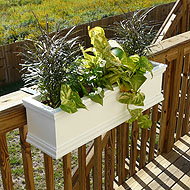 W
WA flower box is a type of container in the form of a planter or box that is usually placed outdoors and used for displaying live plants and flowers, but it may also be used for growing herbs or other edible plants.
 W
WA flowerpot, flower pot, planter, planterette, or alternatively plant pot is a container in which flowers and other plants are cultivated and displayed. Historically, and still to a significant extent today, they are made from plain terracotta with no ceramic glaze, with a round shape, tapering inwards. Flowerpots are now often also made from plastic, metal, wood, stone, or sometimes biodegradable material. An example of biodegradable pots are ones made of heavy brown paper, cardboard, or peat moss in which young plants for transplanting are grown.
 W
WA fuel ladder or ladder fuel is a firefighting term for live or dead vegetation that allows a fire to climb up from the landscape or forest floor into the tree canopy. Common ladder fuels include tall grasses, shrubs, and tree branches, both living and dead. The removal of fuel ladders is part of defensible space 'firescaping' practices.
 W
WGravel is a loose aggregation of rock fragments. Gravel is classified by particle size range and includes size classes from granule- to boulder-sized fragments. In the Udden-Wentworth scale gravel is categorized into granular gravel and pebble gravel. ISO 14688 grades gravels as fine, medium, and coarse with ranges 2 mm to 6.3 mm to 20 mm to 63 mm. One cubic metre of gravel typically weighs about 1,800 kg.
 W
WA growbag is a large plastic bag filled with a growing medium and used for growing plants, usually tomatoes or other salad crops. The growing medium is usually based on a soilless organic material such as peat, coir, composted green waste, composted bark or composted wood chips, or a mixture of these. Various nutrients are added, sufficient for one season's growing, so frequently only planting and watering are required of the end-user. Planting is undertaken by first laying the bag flat on the floor or bench of the growing area, then cutting access holes in the uppermost surface, into which the plants are inserted.
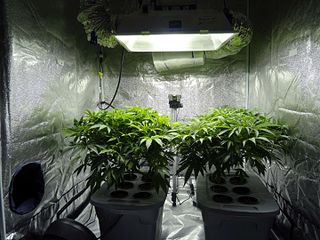 W
WA growroom or growth chamber is a room of any size where plants are grown under controlled conditions. The reasons for utilizing a growroom are countless. Some seek to avoid the criminal repercussions of growing illicit cultivars, while others simply have no alternative to indoor growing. Plants can be grown with the use of grow lights, sunlight, or a combination of the two. Due to the heat generated by high power lamps, grow rooms will often become excessively hot relative to the temperature range ideal for plant growth, often necessitating the use of a supplemental ventilation fan.
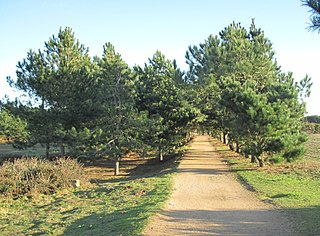 W
WHoggin is a compactable groundcover that is composed of a mixture of clay, gravel, and sand or granite dust that produces a buff-coloured bound surface. It is more commonly seen in the south of England and at National Trust properties. The material is aesthetically suited to older properties and is lower maintenance than gravel alone since it does not need regular raking. Once laid, the surface is somewhat permeable to water and therefore does not easily hold puddles or generate rapid surface runoff. The material is increasingly being used at domestic properties as a low cost and environmentally friendly alternative to concrete and block paving in paths and driveways.
 W
WHydroseeding is a planting process that uses a slurry of seed and mulch. It is often used as an erosion control technique on construction sites, as an alternative to the traditional process of broadcasting or sowing dry seed.
 W
WJardinière is a French word, from the feminine form of "gardener". In English it means a decorative flower box or "planter", a receptacle or a stand upon which, or into which, plants may be placed, usually indoors. The French themselves mostly refer to tabletop "planter" versions of such receptacles as cachepots ("hide-pots"). The French tend to use jardinière for larger outdoor containers for plants, and for raised beds in gardens in some sort of isolated frame, such as a stone wall, especially growing vegetables and herbs.
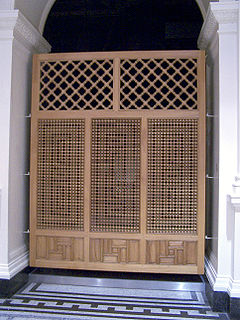 W
WLatticework is an openwork framework consisting of a criss-crossed pattern of strips of building material, typically wood or metal. The design is created by crossing the strips to form a grid or weave. Latticework may be functional – for example, to allow airflow to or through an area; structural, as a truss in a lattice girder; used to add privacy, as through a lattice screen; purely decorative; or some combination of these.
 W
WA pergola is an outdoor garden feature forming a shaded walkway, passageway, or sitting area of vertical posts or pillars that usually support cross-beams and a sturdy open lattice, often upon which woody vines are trained. The origin of the word is the Late Latin pergula, referring to a projecting eave. As a type of gazebo, it may also be an extension of a building or serve as protection for an open terrace or a link between pavilions. They are different from green tunnels, with a green tunnel being a type of road under a canopy of trees.
 W
WA plant LED incubator is a chamber which can automatically control the environment of the plant. It can control the temperature, moisture, and especially light regime of the plant based on light emitting diodes (LEDs). LEDs have efficient electric lighting with desired wavelengths (Red+Blue) which support greenhouse production in a minimum time and with high quality and quantity. As LEDs are cool it helps plants to be placed as close as possible to light sources without overheating or scorching. This saves space for intense cultivation. It could provide the opportunity of greenhouse-produced fruits and vegetable to be available for the market more quickly and less expensively due to the effect of LED lighting on earliness, compactness and quality of products.
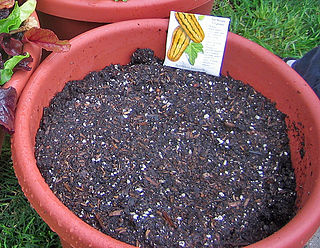 W
WPotting soil, also known as potting mix or miracle soil, is a medium in which to grow plants, herbs and vegetables in a pot or other durable container. The first recorded use of the term is from an 1861 issue of the American Agriculturist.
 W
WIn agriculture and gardening, row cover is any transparent or semi-transparent, flexible material, like fabric or plastic sheeting, used as a protective covering to shield plants, usually vegetables, primarily from the undesirable effects of cold and wind, and also from insect damage. In addition to reducing the drying effect of wind, row cover can provide a limited amount of warming by the same effect that cold frames, greenhouses, and polytunnels produce, creating a microclimate for the plants.
 W
WA sediment control is a practice or device designed to keep eroded soil on a construction site, so that it does not wash off and cause water pollution to a nearby stream, river, lake, or sea. Sediment controls are usually employed together with erosion controls, which are designed to prevent or minimize erosion and thus reduce the need for sediment controls. Sediment controls are generally designed to be temporary measures, however, some can be used for storm water management purposes.
 W
WA shed is typically a simple, single-story roofed structure in a back garden or on an allotment that is used for storage, hobbies, or as a workshop. Sheds vary considerably in their size and complexity of construction, from simple open-sided ones designed to cover bicycles or garden items to large wood-framed structures with shingled roofs, windows, and electrical outlets. Sheds used on farms or in industry can be large structures. The main types of shed construction are metal sheathing over a metal frame, plastic sheathing and frame, all-wood construction, and vinyl-sided sheds built over a wooden frame. Small sheds may include a wooden or plastic floor, while more permanent ones may be built on a concrete pad or foundation. Sheds may be lockable to deter theft or entry by children, domestic animals, wildlife, etc.
 W
WA smudge pot is an oil-burning device used to prevent frost on fruit trees. Usually a smudge pot has a large round base with a chimney coming out of the middle of the base. The smudge pot is placed between trees in an orchard. The burning oil creates heat, smoke, carbon dioxide, and water vapor. It was believed that this oil burning heater would help keep the orchard from cooling too much during the cold snaps.
 W
WSoil moisture sensors measure the volumetric water content in soil. Since the direct gravimetric measurement of free soil moisture requires removing, drying, and weighing of a sample, soil moisture sensors measure the volumetric water content indirectly by using some other property of the soil, such as electrical resistance, dielectric constant, or interaction with neutrons, as a proxy for the moisture content.
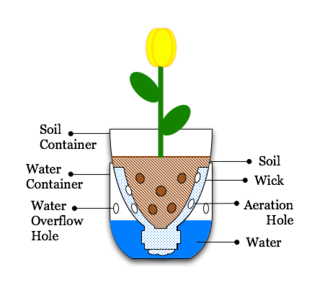 W
WSub-irrigated planter (SIP) is a generic name for a special type of planting box used in container gardening and commercial landscaping. A SIP is any method of watering plants where the water is introduced from the bottom, allowing the water to soak upwards to the plant through capillary action. It is possible to automate the watering and thus SIPs are popular with professional landscapers in buildings or urban settings. Commercialized versions of a Sub-irrigated planter condenses humidity from the environment and feed it directly into the plants' roots. SIPs are available as commercial products or as do-it-yourself projects made from plastic buckets, boxes or storage totes. One of the disadvantages of such closed systems is that soluble salts cannot be flushed into the lower soil profile and build up over time.
 W
WA tap is a valve controlling the release of a liquid or gas.
 W
WA tray is a shallow platform designed for the carrying of items. It can be fashioned from numerous materials, including silver, brass, sheet iron, paperboard, wood, melamine, and molded pulp. Trays range in cost from inexpensive molded pulp trays which are disposable and inexpensive melamine trays used in cafeterias, to mid-priced wooden trays used in a home, to expensive silver trays used in luxury hotels. Some examples have raised galleries, handles, and short feet for support.
 W
WA trellis (treillage) is an architectural structure, usually made from an open framework or lattice of interwoven or intersecting pieces of wood, bamboo or metal that is normally made to support and display climbing plants, especially shrubs.
 W
WA water timer is an electromechanical device that, when placed on a water line, increases or decreases the water flow through the use of an electro-mechanically actuated ball valve or embedded (solenoid) valve. It is used in conjunction with irrigation sprinklers to form an automated or non-automated sprinkler system, capable of administering precise amounts of water, at a regular basis. A water flow timer using a ball valve contains an electric motor with gears to stop or start the water flow by turning a perforated ball within the water flow line. The gearbox in a ball valve timer makes a rumbling sound when actuated. The solenoid type switching timers contain a solenoid that relieves pressure on a diaphragm in the water-flow tube or moves a stopper into the water flow area to regulate flow. The solenoid type uses no gears and makes a tapping sound when the solenoid is activated. Battery powered garden hose timers are the most commonly seen water timers and are seen in two types, the ball valve timer that is actuated by a motor with gears, and the diaphragm timer that is actuated by a solenoid. The solenoid/diaphragm timer uses more battery power throughout the "on" cycle because the solenoid must be actuated the entire time that the water flow is "on". The ball valve timer using the motor and gear actuator only uses more battery power during the few seconds that motor is used to turn the water flow "on" or "off".
 W
WWaterproofing is the process of making an object or structure waterproof or water-resistant so that it remains relatively unaffected by water or resisting the ingress of water under specified conditions. Such items may be used in wet environments or underwater to specified depths.
 W
WA window box is a type of flower container for live flowers or plants in the form of a box attached on or just below the sill of a window. It may also be used for growing herbs or other edible plants.